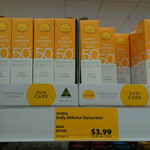It has been two years since I've seen this on the shelves at my local Aldi. It was always a seasonal special and wasn't available all year 'round, and for some reason in recent years Aldi chooses to release it more than halfway through summer. Yes, the price has gone back up to $3.99 which is what it used to be before it was reduced two years ago, but at $6.65/100ml you're unlikely to get anything this cheap with the same comfortable, non-sticky texture with high protection for the face (see price comparison below). It is broad spectrum, fragrance and paraben free. It's suitable for daily use and won't interfere with make-up. If your skin type is on the oiler side, you can wear this on its own and you won't need a separate moisturiser underneath. The last time this was available, it sold out quite quickly so get it while it's available. Expiry on my tube is Nov 2024.
Full ingredients from TGA - see page 2 - from ARTG search
This product has an identical ingredients list as the Cancer Council Face Daywear Moisturiser Invisible Matte SPF50+ (pink tube) (OzBargain's second favourite sunscreen) based on the TGA ARTG listing. See Cancer Council Invisible Matte ingredients.
It's also almost identical to the Natio Daily Defence Face Moisturiser SPF 50+- except Natio has fragrance.
Price comparison:
- Ombra Daily Defence Light Feel - $3.99/60ml which is $6.65/100 ml
- Cancer Council Invisible Matte (pink) - $14.95/75ml but often half price so $7.48/75ml which is $9.97/100ml
- Natio Daily Defence Face - $19.99/100ml sometimes half price so $9.99/100ml
Cancer Council recommends using sunscreen every day on days when the UV Index is forecast to be 3 or above. Sunscreen should be part of your daily morning routine on these days. source. Note that the UV index during daylight hours in summer easily exceed that even on rainy days.


Thanks OP
Have you tried LRP Anthelios / does either one feel better to you?